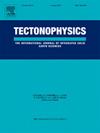日本海沟中动态破裂、海洋声波和海啸的楔形非弹性和完全耦合模型:2011年东北大地震
IF 2.6
3区 地球科学
Q2 GEOCHEMISTRY & GEOPHYSICS
引用次数: 0
摘要
沿日本海沟,沉积物厚度和非弹性楔块变形沿走向变化对近海沟滑动、地震辐射和海啸成因的变化具有重要影响。我们提出了2011年MW 9.1 Tohoku-Oki地震的动态破裂、海洋声波和海啸的完全耦合模型,通过扩展楔形非弹性的动态破裂模型(Ma, 2023),以充分研究海啸产生和辐射场的物理特性。考虑海洋可压缩性的完全耦合模式所产生的海啸与色散浅水模式所产生的海啸一致,证实了两种模式的有效性。我们发现,在39°N以南,由快速破裂速度(~ 3 km/s)和大的近海沟滑动引起的强烈的海声和地震波辐射,以弹性楔响应为主。然而,在日本海沟北部沉积物增厚的39°N以北,非弹性楔块变形有效地激发了海啸,并减少了近海沟滑动(<20 m),这与差分测深观测结果一致,但导致了缓慢的破裂速度(~ 850 m/s)和显著减弱的海声和地震波辐射。因此,非弹性楔变形为本次地震中日本海沟北部高频辐射损耗和大海啸产生提供了自洽的解释,这可能对利用海洋声波进行强海啸预警提出挑战。本文章由计算机程序翻译,如有差异,请以英文原文为准。
Wedge inelasticity and fully coupled models of dynamic rupture, ocean acoustic waves, and tsunami in the Japan trench: The 2011 Tohoku-Oki earthquake
Along-strike variations of sediment thickness and inelastic wedge deformation can significantly affect the variations of near-trench slip, seismic radiation, and tsunamigenesis along the Japan Trench. We present fully coupled models of dynamic rupture, ocean acoustic waves, and tsunami for the 2011 MW 9.1 Tohoku-Oki earthquake to fully investigate the physics of tsunami generation and radiation fields, by extending a dynamic rupture model with wedge inelasticity (Ma, 2023). The fully coupled models, incorporating ocean compressibility, produce tsunami in good agreement with that from a dispersive shallow-water model, confirming the validity of both models. We show strong radiation of ocean acoustic and seismic waves caused by fast rupture velocity (∼3 km/s) and large near-trench slip south of 39°N, dominated by elastic wedge response. However, north of 39°N where sediment thickens in the northern Japan Trench, the inelastic wedge deformation excites tsunami efficiently with diminishing near-trench slip (<20 m), consistent with differential bathymetry observations, but causes slow rupture velocity (∼850 m/s) and significantly weaker radiation of ocean acoustic and seismic waves. Inelastic wedge deformation thus provides a self-consistent interpretation to both depletion in high-frequency radiation and large tsunami generation in the northern Japan Trench in this earthquake, which may challenge the use of ocean acoustic waves for robust tsunami early warning.
求助全文
通过发布文献求助,成功后即可免费获取论文全文。
去求助
来源期刊

Tectonophysics
地学-地球化学与地球物理
CiteScore
4.90
自引率
6.90%
发文量
300
审稿时长
6 months
期刊介绍:
The prime focus of Tectonophysics will be high-impact original research and reviews in the fields of kinematics, structure, composition, and dynamics of the solid arth at all scales. Tectonophysics particularly encourages submission of papers based on the integration of a multitude of geophysical, geological, geochemical, geodynamic, and geotectonic methods
 求助内容:
求助内容: 应助结果提醒方式:
应助结果提醒方式:


